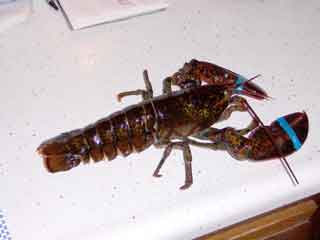First, we should all understand that in most part of the US, when you order lobster at a restaurant, you don't get lobster. Instead, you get some form of crayfish. Yes, it may have lobster in its real local name (not the one on the menu: that will probably just say lobster and be followed by an obscene price), but Florida Lobster, Rock Lobster, Spiny Lobster, Southern Lobster, even (most of the time) Lobster Tail, they're all crawfish. (Check out: http://dictionary.reference.com/search?q=crayfish&r=67
for some definitions . . .)
This is a lobster.

Everything else is not. (Which does not mean that any and/or all of those other creatures are not great eating. They are each wonderful in their own right! But please, do not call them lobsters . . .)
So here's what you need . . .
some crunchy French Bread (or your favorite 'bread with some character')
a big garden salad - lots of fresh grown tomatoes, greens and everything else
2 ears of fresh corn per person
1 lobster each
lemon wedges
and lots of butter (or your favorite butter substitute)
Here’s how you do it.
The usual phrase is ‘boiled Maine lobster.’ Please don’t boil your lobster! Like most seafood, lobster is a delicate meat. When cooked too hot or too long, it gets tough and loses flavor.
The ideal cooking method is steaming over hot rocks covered with seaweed on a sandy beach somewhere. But that’s a tad inconvenient in my kitchen . . . So we use a big bucket and poach the beasts. Get out your favorite big bucket (we use a 12 qt. stockpot or a canning pot), fill it about half full of water, toss in some seaweed if you have any, and bring the water to a full boil.
While the water is heating up, toss a stick or three of butter, or an appropriate quantity of your favorite butter substitute (as I’ve said before, we use Smart Balance), into a small skillet and put it over low heat. At the very least you want to melt the butter. At the most, you can do a full cheesecloth-strained clarification. What’s the difference? About 2 minutes and a piece of cheesecloth . . .
In either case, heat the butter gently until the milk solids settle out onto the bottom of the skillet, and whatever froth forms on the surface. Carefully (slowly) skim the frothy stuff off and throw it out. Let the milk solids ‘cook’ for a few more minutes in the butter and then just pour off the clear butter, leaving the solids in the pan. Or strain the butter through the cheesecloth.
At that point, I usually give the skillet a quick wipe, pour the butter back in and add a goodly slug of olive oil. I shoot for about 1/3 oil, 2/3 butter, but you can use whatever proportions you like, or skip the oil altogether, or hey, skip the butter altogether and just use olive oil! If you want, you can squeeze a fresh lemon or two into the butter/oil, but I prefer the sharp zing of lemon juice at the table, one bite at a time. You can leave the skillet on barely-there heat until it’s time to serve.
When your bucket of water is boiling, get your lobsters out of the fridge, gently roll them into the sink and snip the rubber bands on their claws. (I don’t know about you, but I prefer the flavor of lobster over that of boiled rubber . . .)

When they’re all snipped, pick up the lobster body from behind the big claws and plunge the lobster head first into the boiling water. Get all the lobsters into the pot as quickly as you can so they’ll all be done at the same time.
Put the lid on the pot, turn the heat to medium low, and check the clock. In 18 minutes, you’ll be ready to eat.
Why 18? ‘Cause it works for me . . . Look, when you plunge the cold lobsters into that half pot of boiling water, you reduce the water temperature dramatically. It’s going to take a good 7 minutes to get back to a comfortable poaching temperature. And 10 – 11 minutes after that to poach a 1 – 3 lb. lobster is just about right. You could leave the heat on high to try to reduce the time a little, but then you’d ‘boil’ your lobster and ruin it. So be patient, cook slowly, and you’ll reap the reward.

Besides you’ve still got corn to cook! So put about 2 inches of water in the bottom of your corn pot. You want to steam your corn, not boil it. Cover the pot and put it over high heat to bring it to a boil. When you’re about 6 or 7 minutes away from taking the lobsters out, put the corn in, cover the pan, and again, turn the heat down to medium low. Fresh corn on the cob is very delicate. Five minutes in the steam is plenty to cook it. When the time is up, turn off the heat, uncover the pan and just let the corn sit there while you get the lobsters out.
Then haul everything to the table and dine in glory!

No comments:
Post a Comment